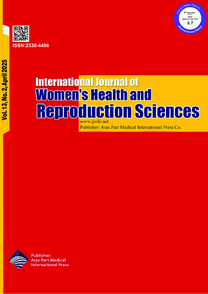| Original Article | |
| Factors Affecting Postpartum Overt and Covert Urinary Retention After Vaginal Delivery | |
| Azita Ghanbarpour1,2, Shahnaz Barat1, Fatemeh Amirkhanloo3, Karimollah Hajian4, Zinatossadat Bouzari5 | |
| 1Infertility and Reproductive Health Research Center, Health Research Institute, Babol University of Medical Sciences, Babol, Iran 2Clinical Research Development Unit of Rouhani Hospital, Babol University of Medical Sciences, Babol, Iran 3Student Committee Research, Babol University of Medical Sciences, Babol, Iran 4Department of Biostatistics and Epidemiology, Babol, Iran 5Cellular and Molecular Biology Research Center, Health Research Institute, Babol University of Medical Sciences, Babol, Iran |
|
|
IJWHR 2023; 11: 073-081 DOI: 10.15296/ijwhr.2023.13 Viewed : 2387 times Downloaded : 2839 times. Keywords : Urinary retention, Women, Pregnancy, Instrumental delivery, Urinary symptoms, Body mass index |
|
| Full Text(PDF) | Related Articles | |
| Abstract | |
Objectives: The aim of this study was to investigate the factors affecting postpartum urinary retention (PPUR) following vaginal delivery. Materials and Methods: This cross-sectional analytical study measured the post-void residual (PVR) urine volume by ultrasound, at most, 15 minutes after the first urination after delivery. Women with a PVR >150 mL without urinary symptoms were assigned to the postpartum covert urinary retention group. Data were analyzed with SPSS22. The chi-square and Mann-Whitney tests were used for quantitative and qualitative variables, respectively. Results: In this study, 1120 patients had a normal delivery at Ayatollahs Rouhani hospital from 21 January 2016 to 20 January 2017. Of this number, 306 (29.4%) and 734 (70.6%) cases with and without urinary retention were allocated to the case and control groups, respectively. Women with instrumental delivery had 30.19 times (P = 0.003) higher odds of urinary retention. Instrumental delivery is one of the known risk factors of urinary retention. The linear effect of the total length of labor was also measured, and the results revealed that every one-minute increase in the total length of labor increases the odds of covert urinary retention by 1.008 times (P < 0.001). Conclusions: The findings of the study showed that various factors are involved in the incidence of urinary retention. More precisely, instrumental delivery, birth weight, gestational age, and other factors can each be a risk factor for urinary retention. |
Cite By, Google Scholar
Google Scholar
PubMed
Online Submission System
 IJWHR ENDNOTE ® Style
IJWHR ENDNOTE ® Style
 Tutorials
Tutorials
 Publication Charge
Women's Reproductive Health Research Center
About Journal
Publication Charge
Women's Reproductive Health Research Center
About Journal
Aras Part Medical International Press Editor-in-Chief
Arash Khaki
Mertihan Kurdoglu Deputy Editor
Zafer Akan























